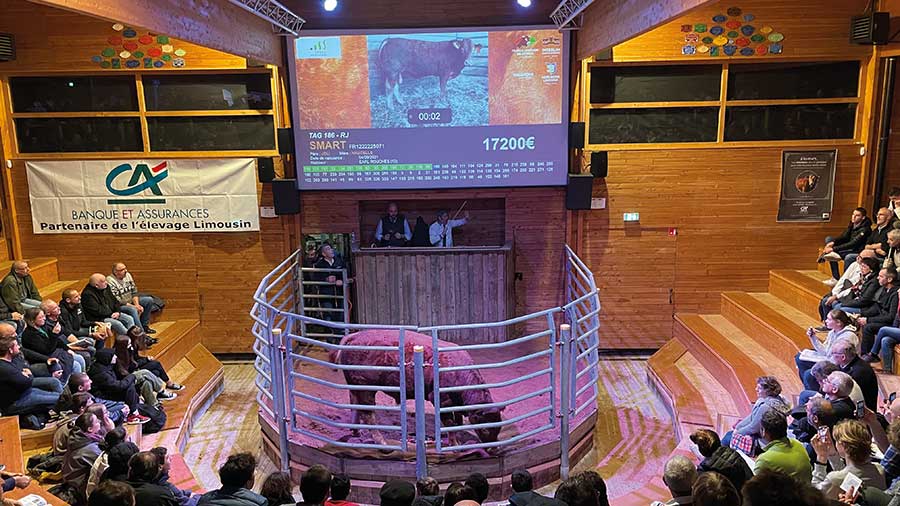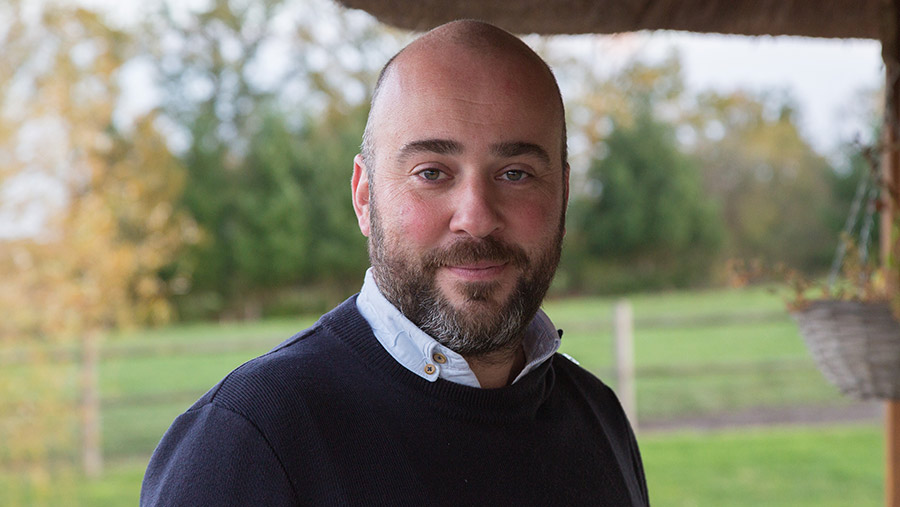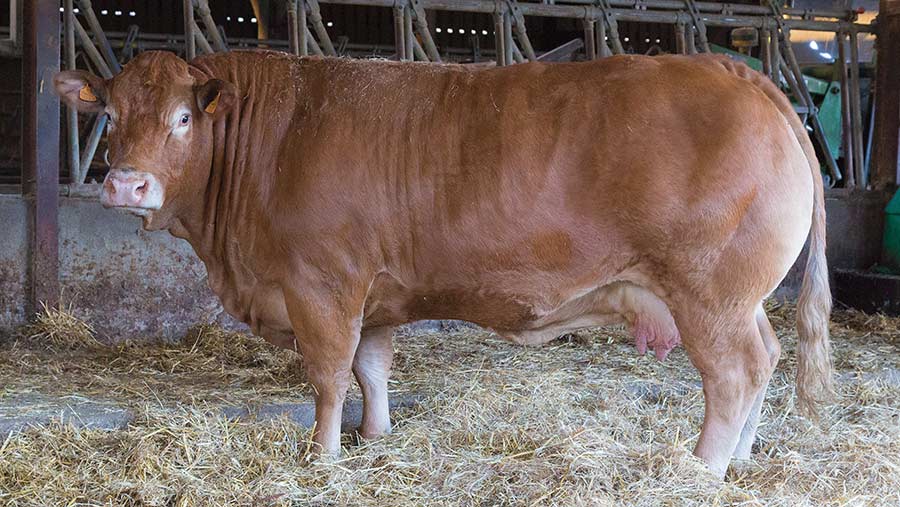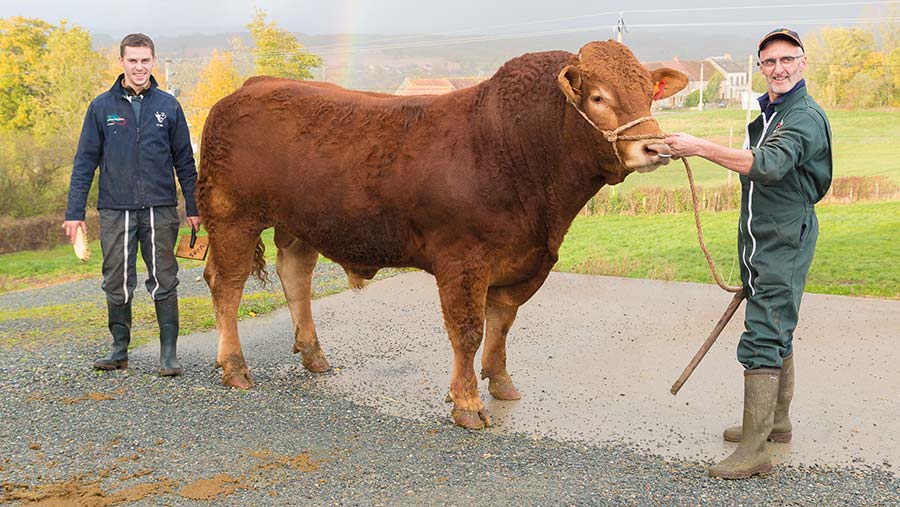How French Limousin breeders work together to improve their herds
 © France Limousin Sélection
© France Limousin Sélection
An integrated approach to developing and promoting the Limousin breed in France is giving beef producers the tools to get the best from their cattle.
The French Limousin organisation, Le Pôle de Lanaud, brings together under one roof:
- Herd-book Limousin, which certifies pure-bred Limousin cattle for breed members
- France Limousin Sélection (FLS), responsible for breed selection
- Interlim Génétique Service, the commercial arm of FLS, selling breeding cattle, semen and embryos in France and internationally
- Station de Lanaud, where bull calves, selected from member farms, are evaluated and ranked ready for sale
- Ingenomix, which carries out genomic testing to predict the genetic potential of cattle.
See also: 10 ways one farm makes suckler beef profitable
The centre, on a farm just outside Limoges, also hosts Limousine Park, an agritourism visitor attraction, and Le Lanaud, a 100-seat restaurant showcasing Limousin beef and other local produce.
At the heart of Le Pôle de Lanaud is the sale ring, where four two-day bull sales are held each year, in January, March, June and November.
The sale ring holds up to 450 people, and online buying, set up during Covid restrictions and maintained since, attracts a further 300 potential buyers.

Olivier Rambert © MAG/Judith Tooth
“The best way is to come here,” says Olivier Rambert, commercial manager of Interlim, which takes a margin on sales and an annual fee from members via Herd-book Limousin.
“You can connect with people, meet friends, as you would at, say, Carlisle. It makes for a good ambience, and when you have that, you have a good sale.”
In person or online, it is the selection and evaluation of bulls in the run-up to these sales that really draws potential buyers keen to improve the performance of their herds year on year.
Bull selection
To prepare for the sale of the 500 bulls that qualify each year from this selection process, the most promising 700 bull calves are chosen from among the farmer members of Herd-book Limousin.
These bulls are then evaluated to determine their breeding potential.
Between them, these 1,400 farmers own 100,000 registered pedigree cows, or one tenth of France’s total Limousin herd.
Julien Mante, technical manager of FLS, manages the on-farm selection programme.
He heads a team of 13 technicians who work with members across France, registering calves, making mating plans for their herds, selecting young male calves for the testing station, and helping identify the best heifers as herd replacements.
“Breeders put male calves forward for consideration for testing – in total, about 2,400 a year,” he explains.
“Technicians then check them on farm and select 700. This represents 30% selection pressure. Then, before the young bulls arrive, Interlim and the technicians check them again and filter out a further 100.”

© MAG/Judith Tooth
How are they tested?
The bulls – brought to Le Pôle de Lanaud just after weaning – remain the property of their breeders throughout the selection programme.
Breeders pay €1,000 (£864) for five months’ board, during which time the bulls are housed in a series of identical open-fronted barns.
The aim of bringing them all to one site is so they are all in the same environmental conditions, says Mr Mante.
The first test is for docility. “Temperament is very heritable and has really improved over the 30 years we have done this test,” he says.
About 6% of bulls return to their farms during the first month. During the testing period, the bulls are weighed, measured for pelvic area – as they will transfer this trait to their female progeny – and scored.
They are then ranked using a synthesis of estimated breeding values (EBVs) for ease of calving, growth, muscle and skeletal development, building on data gathered at birth and at weaning.
“EBVs don’t measure everything – we still want a straight back, for example,” says Mr Mante. “So, we give each bull a synthesis of EBVs and then validate it in the shed for functional abilities.”
They are then given one of two qualifications:
- Reproducteur jeune (RJ) for the best 50% of bulls tested
- Espoit – the remaining bulls.
Bull sales
A sale catalogue is then produced, which is also accessible via the Mon Lanaud app.
Each entry shows the bull’s pedigree, its EBVs and those of its parents, and genetic information.
There is a difference in sale price of about €2,500 (£2,158) between RJ bulls – 80% of which go to pedigree herds or are sold for export – and Espoit bulls, which are bought by commercial breeders to improve herd performance.
“Buying a good bull is an investment, but it’s not [like buying on] Amazon – so [we say] come and have a look at him, even if it’s not on sale day,” says Mr Rambert.
“Bulls are qualified three to four weeks before a sale, and the station is open – you don’t have to book.”
Selling a bull also has benefits beyond the sale price, he adds. “If your bull qualifies, it’s an accomplishment and a source of pride. And it’s very good for your reputation among buyers.
“Over the past five years, we’ve had 800-1,000 suppliers, and we want to cultivate that – we don’t want to see the same names, the same genetics each time – we want a broad range of bloodlines.”
Artificial insemination
A further stage in the selection process involves the best 36 bulls and takes place at another testing station an hour from Le Pôle de Lanaud.
This is an important part of the selection programme, says Mr Mante, and involves additional evaluation for feed efficiency.
From these 36, the best 10 are retained as bulls for artificial insemination (AI).
Genomic testing
Indexes for 50,000 Limousin bulls are held by Ingenomix, set up in 2010 to apply genomic research to beef selection for the benefit of members.
Solange Fauresson, head of service, explains:
“Using genetics, along with breeding practices, helps producers achieve the goal of [producing] one calf a cow a year, which is the objective of any breeder for good livestock productivity.
“We’ve been collecting data since the 1960s – birthweight, growth rates, milking ability and so on. Before, this was only indexed, but now, we can use historical information with new DNA to make new predictions.”
Ingenomix receives 150-200 hair samples a week for DNA testing. Breeders pay €50 (£43) for a test for a female and €150 (£130) for a male.
Some additional traits not available in national indexes are also assessed: pelvic size, udder morphology and interval from calving to first heat.
Ingenomix researcher Eric Fontanillas will be speaking about using genomic selection to improve beef cattle fertility at the British Cattle Breeders’ Conference on 24 January.
Case study: GAEC Desassure, L’Etat, Cheniers, Creuse

© MAG/Judith Tooth
Farm facts
- 300ha (741 acres) in organic production
- 30ha (74 acres) cereals, 20ha (49 acres) maize silage
- 40ha (100 acres) permanent pasture; remaining area in three-year grass leys
- 170 pedigree Limousin cows, including first-time calvers
- Mainly autumn calving herd, calving outdoors and wintered in yards
Father-and-son team David and Jeremy Desassure farm in the rolling countryside of Creuse in the Limousin area of France.
They run a predominantly autumn-calving herd of pedigree Limousins and over the past 20 years have invested in 10 bulls from the sales at Le Pôle de Lanaud to improve herd performance.
Their newest bull is RJ Starsky, bought with a neighbouring farmer for €12,200 (£10,452) at the November bull sale.
He joins RJ Rafiot, another top-performing bull that went through the selection programme at the testing station at Lanaud.
“I’m looking for good bloodlines, maternal traits, length, power and good balance,” says David Desassure.
“If you buy from farms, you get mixed results, but if you buy from Lanaud, it’s rare that you don’t get good results.
“Those farmers who have bought bulls from Lanaud during the past 20 years have made huge progress in their herds.”
Cattle are housed in winter, with cows on a ration of maize and grass silage with a little hay and straw. Grain is kept for finishing animals.
For an organic system, it would be more economical to calve in early spring so that calves and cows could profit from the growing grass until weaning in August, says Mr Desassure.
This is something they are considering, but they are concerned about the impact such a move might have on calf health.
Currently, cows calve outside before coming in for winter, and calves suffer few health issues, whereas switching blocks would mean calving indoors, which could result in a higher incidence of diarrhoea, for example.
However, the farm’s ongoing organic status is under review because organic beef prices have levelled with conventional production in France.
This, along with rising input costs and lower organic crop yields, is threatening the viability of this type of production at L’Etat.
Cull cows
There is good money for cull cows, however – especially those under 10 years of age – and France traditionally favours cow beef.
Thanks to ongoing investment in genetics, the Desassures are confident new generations of cows will perform well and are exploiting this market by culling hard and bringing in more replacement heifers.
One cull cow made €7,000 (£5,997) at an auction in Limoges in early October. She came back to the farm for finishing and was slaughtered two months later.
Unusually for French suckler herds, the Desassures use a lot of AI – 80% of their heifers are AI’d, compared with a national average of 15%.
With the skills to detect heat and inseminate, they prefer AI, using semen from their own bulls.
“We spend a lot of time choosing good bulls, and using AI means we can use their semen more widely and still get them ready for shows,” explains David.
Finishing options
Management of bull calves has also changed this year. Usually, about a third of bulls are sold for breeding, another third is castrated at 9-10 months and finished on farm, and the rest go to northern Italy for fattening.
However, this year, with a drop in the organic beef price, steer production has been abandoned and more cattle have been exported to Italy.
David says the adaptability of his cattle to meet a range of markets means they can take such changes in their stride.
“That’s [the] exceptional [thing] about Limousins,” he says. “In three to four months, you can kill anything if you need the money. Few breeds offer this.”
